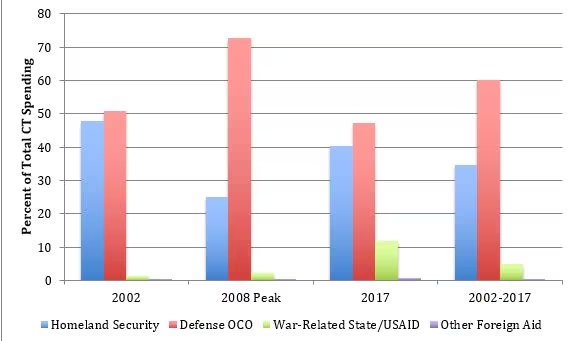WASHINGTON — From fiscal 2002 to 2017, the U.S. spent 16 percent of its entire discretionary budget as part of the counterterrorism fight, a new report has found.
Counterterrorism funding — a broad term that includes government-wide homeland security efforts, international funding programs, and the wars in Afghanistan, Iraq, and Syria — totaled $2.8 trillion between fiscal year 2002 and 2017, per the newly released Stimson Center study.
That’s an average of $186.6 billion per year over 15 years. For comparison, that figure represents more than the overall 2017 defense expenditures of Russia, India and South Korea combined. The yearly average would also top the combined yearly average spent by the United States in the Korean and Vietnam wars, according to a government estimate using FY2011 dollars.
Spending on counterterrorism peaked in 2008 with around $260 billion, a figure that dipped to $175 billion in 2017. Even that low figure would still represent almost 2.5 times the Trump administration requested for its Health and Human Services budget for FY19.
As the authors note, terrorist actions by Muslim extremists or jihadis since the September 11, 2001 attacks have killed 100 people in the United States, or about six per year. In comparison, the opioid overdoses in the United States led to more than 20,000 deaths in the United States during 2016 alone.

During that 15-year period, homeland security spending totaled $979 billion (35 percent of the overall counterterrorism figure), emergency and overseas contingency operations (OCO) spending at DOD totaled $1.7 trillion (60 percent), war-related spending at State/USAID totaled $138 billion (5 percent), and non-OCO counterterrorism foreign aid totaled $11 billion, less than half a percent of the total figure.
While produced by the Stimson Center, the report relied heavily on a bipartisan group of defense experts, including two former Pentagon comptrollers in Tina Jones and Mike McCord; defense expert Mackenzie Eaglen of the American Enterprise Institute; Luke Hartig, a former senior director for counterterrorism on the National Security Council; Amy Belasco, a budget expert who has worked with both the Congressional Research Service and Congressional Budget Office; and John Mueller, a terrorism expert at the Cato Institute.
By the authors’ own admission, the nature of tracking counterterrorism funding through the various accounts means the final figure is “imprecise,” but the figure represents the closest to a single number that has been assembled by the national security community.
Worryingly, the group concluded that “the transparency of current data is eroding,” with one key report — the Office of Management and Budget’s annual homeland security report — having been discontinued for fiscal year 2018.
As a result, the working group concluded that the United States government needs to create a solid definition of just what counterterrorism funding actually includes. To get to that point, they recommended a five-step plan:
- Create a clear and transparent counterterrorism funding report, with Congress requiring OMB to compile and analyze data governmentwide to provide solid metrics on spending.
- Adopt a detailed agencywide definition for counterterrorism spending, which would involve OMB and Congress developing a “a clear, usable set of criteria” to define counterterrorism spending and show how those dollars are being used to protect American civilians from terrorist threats.
- Plan for future budget pressures by sorting out counterterrorism spending at the program, activity, and project levels, identifying ongoing vs. incremental emergency needs.
- Tie the definition of war spending to specific activities. The goal here would be to separate counterterrorism and war spending, in part thanks to the infamous OCO spending mechanism which allows a variety of mission sets to be rolled into the war funding account.
- Similarly, the working group calls on Congress to pass new legislation that requires it to vote separately to approve spending that is designated as war-related emergency or wartime overseas contingency operations spending before those funds can be obligated.
“These five recommendations would do much to make budget data on overall counterterrorism programs and activities more systematic and available to budget planners, Congress, and the public,” the authors concluded. “This data would be an essential tool for creating a more systematic process of evaluating the effectiveness of these programs.”
Aaron Mehta was deputy editor and senior Pentagon correspondent for Defense News, covering policy, strategy and acquisition at the highest levels of the Defense Department and its international partners.







